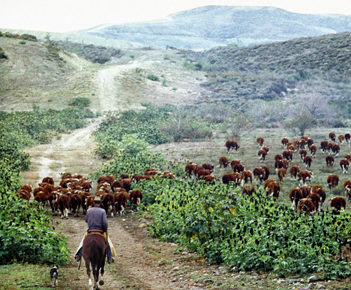Cattle, sheep and horses once grazed on the land that was to become known as The Irvine Ranch®.

In 1886, when the senior James Irvine died, his son, James Irvine Jr., took over operations of The Ranch and began the transition from ranching to farming. He built an agricultural empire where tenant farmers grew a number of crops, including lima beans, black-eyed peas, sugar beats, walnuts, avocados, strawberries, lemons and oranges. Although farming became The Ranch’s primary focus, remnants of The Ranching days lingered for many years. It wasn’t until June 27, 1958, that Myford Irvine (James Irvine Jr.’s son) announced that sheep no longer would be herded on The Irvine Ranch, bringing an end to the era of one of The Ranch’s first commodities.
Over the past four decades, another crucial transition has taken place as The Ranch has become known internationally for its comprehensive master planning. While much of the agricultural land has transitioned into well-balanced communities that include residential villages, retail and commercial centers and excellent schools along with parks and open space, agriculture remains as a reminder of earlier days. In fact, The Irvine Ranch is still one of the nation’s largest providers of avocados.
However, The Ranch today reflects the change that came in response to rapid population growth in this region, which created tremendous demand for both residential and commercial land uses. During the 1950s and 1960s, Orange County was the fastest-growing county in the nation. The county’s population tripled in the 1950s, swelling from 216,000 to 703,000. It doubled to about 1.4 million during the 1960s.
It was at this point that the Irvine Company faced a crucial decision-whether to sell or develop the land piece by piece in response to the pressures of urbanization, or keep The Ranch intact and create a comprehensive, long-range Master Plan to ensure that development would be carefully thought out and would reflect the highest standards.
A historic decision was made to conduct an unprecedented experiment in master planning. In 1960, 32-year-old Ray Watson–a Bay Area architect who had designed schools, churches and other public buildings–was hired as the Irvine Company’s first planner and was given the challenge of guiding the preparation of the Master Plan for The Irvine Ranch. Watson worked closely with acclaimed architect and urban planner William Pereira, who was commissioned to create an unprecedented vision for an entire new master-planned community that would be established alongside a new University of California campus (which became UC Irvine). With Watson and Pereira at the planning helm, the Irvine Company began the task of redefining urban planning by creating model communities that offer a balanced mix of homes, jobs, shopping centers, schools and, of course, parks and open spaces.
Since the adoption of the Master Plan by the cities on The Irvine Ranch, the remaining agricultural land has been envisioned as a transitional use. The Irvine Company has since maintained a sharp focus on creating communities on The Irvine Ranch that fulfill the vision of the Master Plan.

